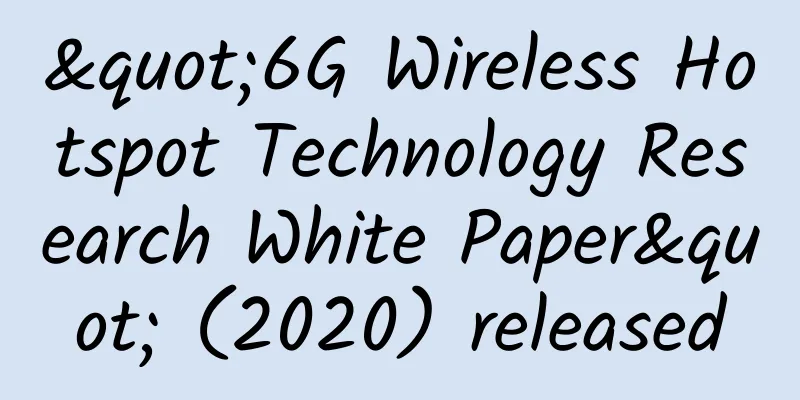6G Proposal: Entering a new stage and meeting new challenges

|
At the 44th meeting of the ITU-R WP5D, the ITU completed the "Recommendation on the Framework and Overall Objectives of IMT for 2030 and Beyond" (hereinafter referred to as the "Recommendation") as scheduled. As a 6G programmatic document, the "Recommendation" plays a macro-guidance role in the development of 6G worldwide. my country has always adhered to innovation-driven development, oriented to 6G, established an industry promotion platform, systematically promoted 6G research and development, and fully supported the future development of the 6G industry. Global 6G development enters a new stageAs the name of the "Recommendation" indicates, it brings together the world's beautiful vision and expectations for 6G, describes the goals and trends of 6G, and proposes a typical scenario and capability indicator system for 6G. It is an overall document guiding the development of 6G. With the release of this document, the global 6G development has entered a new stage. On the basis of sufficient accumulation of technology, the technical direction will gradually converge, the 6G system framework will become clearer and clearer, and international standardization work will also be put on the agenda. my country took the lead in launching the 6G research and development layout, established an industry promotion platform, and systematically promoted 6G research and development. As the main industry platform for promoting the development of 6G, the IMT[1]2030(6G) Promotion Group (hereinafter referred to as the 6G Promotion Group) has attracted more than 80 members from home and abroad to systematically promote 6G demand research, technology research and development, international cooperation and other work, publicly release 6G white papers and a series of technical research reports, organize 6G technology collection and technical trials, and develop concept prototypes to support future 6G industry research and development. In June 2021, the 6G Promotion Group released the white paper "Overall Vision and Potential Key Technologies of 6G", proposing that 6G will support the realization of the vision of "intelligent connection of all things, digital twins", and innovatively proposed that 6G potential business applications will be immersive, intelligent and global. In July 2022, the 6G Promotion Group released the white paper "6G Typical Scenarios and Key Capabilities", proposing that 6G will continue to deepen on the basis of the three typical scenarios of 5G, build super wireless broadband, ultra-large-scale connections, and extremely reliable communication capabilities, and expand new scenarios of perception and intelligent services. At the same time, from the perspective of user, network operation and sustainable development needs, the 6G Promotion Group has studied and proposed a 6G key capability indicator system. All parties in my country's industry have been actively participating in ITU 6G-related work, cooperating with the world to clarify the development direction of 6G and promote the formation of global consensus. The research results of my country's 6G development concepts, typical scenarios and key capability indicators are fully reflected in the "Recommendation". Opportunities and challenges of six typical scenariosBased on the three typical scenarios of 5G, 6G continues to deepen and enhance, building immersive communications, ultra-large-scale connections, extremely high reliability and low latency, and expanding new scenarios of perception and intelligent services (that is, the integration of artificial intelligence and communications, and the integration of perception and communications). Inclusive intelligence will also empower other scenarios to achieve a leap in network performance and service capabilities. At the same time, new ubiquitous connection scenarios will be added to narrow the "digital divide" and connect unconnected users. On the one hand, the six typical scenarios reflect the development trend of immersive, intelligent and global 6G business. 6G will provide diversified services for people, machines and objects, and become a new digital infrastructure that carries new users and enables new applications. On the other hand, it realizes the deep integration of cross-domain technologies, which not only expands the boundaries of 6G services, but also injects new impetus into improving 6G network performance. But at the same time, the six typical scenarios have also brought new challenges to the development of the industry. First, 6G continues to deepen and enhance the three typical scenarios of 5G. The industry needs to combine the experience of 5G commercialization, further deepen the research on the needs of vertical industries such as industry, energy, transportation, and medical care for 6G, and analyze the needs of vertical industries for 6G network performance, which involves cost, complexity, security, uninterrupted service capabilities, etc. At the same time, facing the needs of vertical industries, the industry must accurately identify the application positioning of 6G services and provide a one-stop industry application solution integrating multiple technologies. Secondly, in terms of key technologies, especially in the cross-integration fields of perception, intelligence, and computing, the industry needs to solve the technical problems brought about by cross-domain integration or integrated design while drawing on the technical advantages of the original fields, and realize the integration of communication, computing, models, and data from the perspectives of resources, functions, and services, thereby achieving more efficient services. In addition, some 6G key technologies such as artificial intelligence, perception, and intelligent super-surfaces have been studied in the 5G-Advanced stage, and the optimization and maturity of technologies should be accelerated through industrial collision and running-in. Concept prototypes have been put into practice for some capability indicatorsThe "Recommendation" defines 15 capability indicators of 6G, namely peak rate, user experience rate, spectrum efficiency, regional traffic capacity, connection density, mobility, latency, reliability, coverage capability, positioning accuracy, perception-related capabilities, AI-related capabilities, security privacy and resilience performance, sustainability, and interoperability. The capability indicators reflect the performance level of 6G in supporting six typical scenarios. By type, the capability indicators include four categories of indicators: communication, perception, intelligence, and security sustainability. The last three categories are newly introduced indicators for 6G, and the fourth category of indicators corresponds to the design goals of sustainability, security, privacy, and resilience emphasized by 6G. As a new generation of intelligent integrated digital information infrastructure, 6G has typical characteristics such as ubiquitous interconnection, inclusive intelligence, multi-dimensional perception, full coverage, green and low-carbon, and inherent security. The above indicators are also the definition and quantification of these characteristics. It should be pointed out that the capability indicators defined by ITU do not require that each indicator in each typical scenario be optimal. The capabilities of different scenarios have different focuses. For example, for the synaesthesia fusion scenario, there are high requirements for perception, but the requirements for communication and intelligence indicators will be moderately relaxed. Perception-related capabilities are mainly aimed at the scenarios of perception and communication fusion. The fusion of the two can make more efficient use of spectrum and software and hardware resources. Through perception capabilities, 6G networks can obtain spatial information of non-connected devices and the surrounding environment. On the one hand, it supports immersive services that realize virtual and real symbiosis; on the other hand, it assists in improving communication performance through spatial information. 6G supports multiple types of business perception, including navigation, pattern recognition, imaging, etc. From the perspective of the integrated development stage, 6G supports the business coexistence stage in which communication and perception try to avoid mutual influence, the mutual assistance stage in which communication and perception single-point technologies assist each other, and the network co-benefit stage at the integrated communication and perception system level. According to the requirements of different businesses and different development stages, the perception indicators have different focuses, including at least indicators such as distance accuracy/resolution, velocity accuracy/resolution, Doppler accuracy/resolution, angle accuracy, detection probability, and recognition accuracy. Intelligent indicators are mainly aimed at scenarios where artificial intelligence and communications are integrated. The 6G Promotion Group released the "6G AI as a Service (AIaaS) Demand Research Report" in April 2023, pointing out that through the connection, computing, data, model and other resources and functions of the 6G network, AI capabilities that adapt to different application scenarios are provided, including AI to help improve network performance and the network becoming an efficient operating base for intelligent applications. Intelligent indicators include model/computing performance indicators such as reasoning accuracy, reasoning latency, and energy consumption, data indicators such as data integrity and redundancy, and service performance indicators such as service accuracy, service coverage, and system energy efficiency. Regarding new indicators of security and sustainability, 6G will effectively improve network security and digital security by building endogenous security mechanisms and enhancing the coordination of equipment security capabilities. 6G takes green and low-carbon as the basic principle of network design, and integrates energy-saving concepts into multiple links such as technology innovation, system design, and network operation and maintenance to reduce 6G's own energy consumption and enable the industry to develop in a low-carbon manner. At present, the ITU has given a preliminary definition of the indicator, but has not yet determined how to quantify and evaluate it, and the industry needs to continue research in the subsequent technical performance requirements stage. The industry has actively invested in the research and development of 6G technology, and has accumulated experience in the integration of interaesthesia and communication AI, and has carried out the practice of conceptual prototypes. In addition to single-point technology and single-scenario solutions, 6G, as an organic whole, needs to consider how to maximize the performance and industrial advantages of the 6G system: in terms of access capabilities, support the coordination of medium, low and high frequency bands, design transmission technologies and protocols that take into account multiple scenarios, and achieve flexible networking; in terms of service capabilities, 6G networks should provide richer services, such as data services and computing power services; in terms of deployment and operation, network autonomy, elasticity and openness should be achieved. The 6G framework and overall goals have been determined, and 6G has entered a critical stage of technology reserve. my country should continue to strengthen collaborative innovation among industry, academia, research and application, adhere to the combination of technological breakthroughs and industrial practice, draw on the successful development experience of 5G, and make solid progress to contribute "Chinese strength" to the global 6G development. |
<<: DHCP in 37 pictures: The invisible person who gives you your IP address
>>: Revolutionizing Connectivity: Benefits of Power over Ethernet Solutions
Recommend
TNAHosting: 500GB hard drive VPS from $4 per month, 4GB memory VPS from $4 per month
TNAHosting recently held a Happy Near Year event,...
The 2G era will not come to an abrupt end; network transformation requires the support of the Internet of Things
Recently, China Unicom announced that it will car...
Blockchain and what it means for big data
Blockchain is arguably one of the most significan...
Tudcloud: Hong Kong VPS with 20% off monthly payment and 30% off annual payment starting from $7.2/month, with options of large bandwidth or unlimited traffic
Tudcloud has launched this month's regular pr...
Huawei launches OceanStor Dorado V6, a new generation of intelligent storage, explaining how data creates value
[51CTO.com original article] Huawei recently rele...
CMIVPS: US VPS monthly payment 60% off, annual payment 50% off, Seattle high-security AS4837 line optimization starting from $4/month
This month, CMIVPS is offering a limited special ...
WOT2018 Wang Xiaobo: The "Phoenix" model of cache management, you deserve it
【51CTO.com original article】Seven years of hard w...
Embedded CAN Bus Introduction (Low-Level Details)
[[377418]] 1. Introduction CAN bus was developed ...
A brief discussion on the 3PC protocol for distributed system consistency
This article is reproduced from the WeChat public...
Looking back at the shadows that 2G brought to us in those years
[[247708]] Image source: Visual China There is no...
As the demand for connectivity surges, 5G becomes the key to sustainable development of the ICT industry
[[343025]] As the global energy crisis intensifie...
Here is everything you want to know about 5G progress and next steps
The progress of 5G has always been a key topic of...
Is SDN going to die? See what everyone is saying!
With the advent of network automation, programmab...
LuxVPS: €3/month KVM-4GB/30GB/1TB/Germany data center
The LuxVPS domain name was registered in June 202...
Wi-Fi vs. Ethernet: How Better Is a Wired Connection?
Wi-Fi is obviously more convenient than wired Eth...









